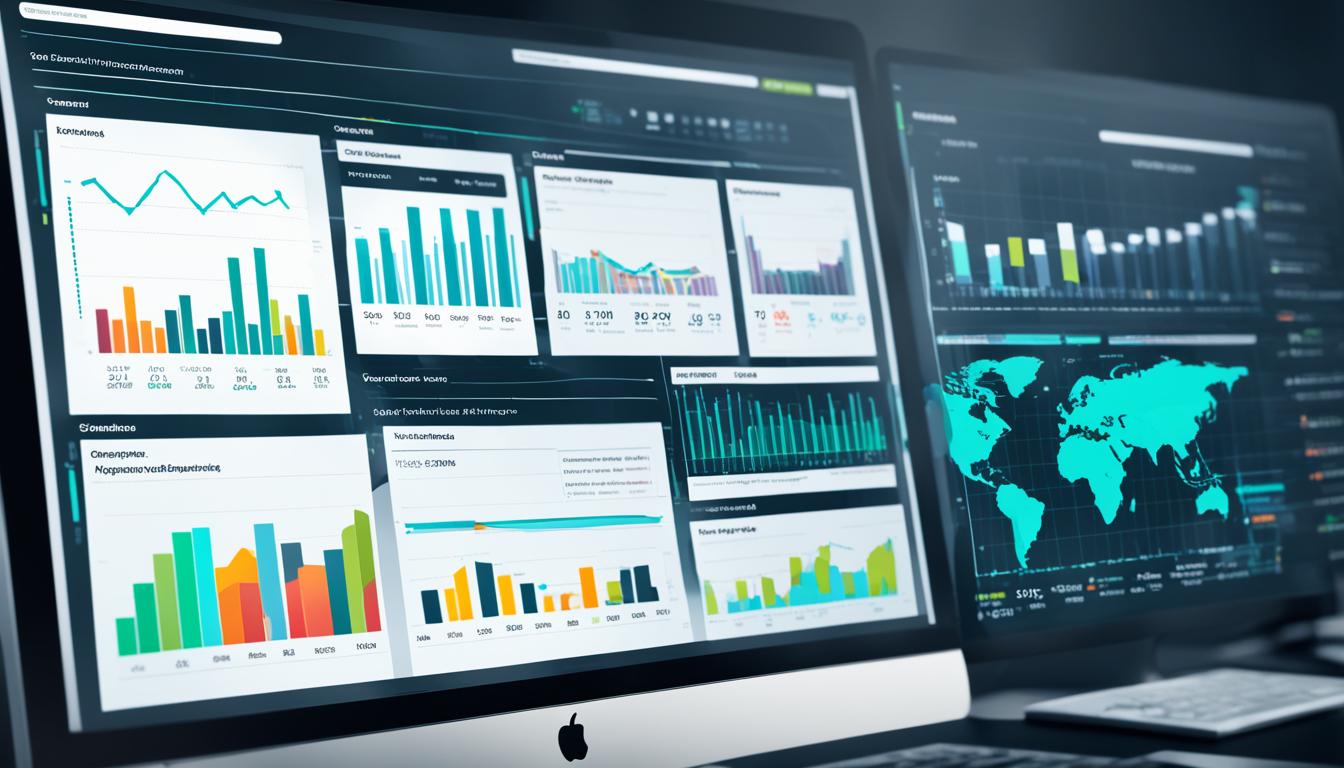What is Splunk: Unveiling Data Insights and Analytics
Have you ever wondered how organizations transform vast amounts of data into actionable insights? How do they make sense of the complex web of information and derive meaningful knowledge? Well, the answer lies in a powerful platform called Splunk.
Splunk is more than just software—it’s a game-changer in the world of data analytics. It collects, indexes, and correlates data from various sources, providing organizations with real-time insights that drive innovation and growth. But what exactly is Splunk, and how does it revolutionize the way we analyze and utilize data?
In this article, I will take you on a journey to unravel the mysteries of Splunk. We will dive deep into its functionalities, explore its purpose, and understand the advantages it offers. Whether you’re a data scientist, an IT professional, or a business leader, Splunk has something to offer you.
Key Takeaways:
- Splunk is a leading platform for operational intelligence that collects, indexes, and correlates data from various sources.
- It offers real-time analysis and monitoring capabilities, advanced search and visualization features, and predictive analytics using machine learning.
- Splunk enhances operational efficiency, improves security, and provides insights into IT infrastructure and business operations.
- By leveraging technology in business process analytics, organizations can optimize their processes, reduce costs, and enhance customer satisfaction.
- Implementing business process analytics involves a step-by-step approach, including data collection, analysis, and continuous monitoring.
Understanding Splunk
Splunk is a powerful data-to-everything platform that serves as a centralized hub for aggregating data from various sources. It collects, indexes, and correlates data in real-time, allowing organizations to gain instant visibility into operational performance, security threats, and system health.
Splunk offers advanced search and visualization capabilities, empowering users to explore and analyze data using powerful queries and intuitive visualizations. With its user-friendly interface and robust search functionality, Splunk enables users to efficiently navigate through vast amounts of data, uncovering valuable insights.
Furthermore, Splunk leverages machine learning and AI-driven capabilities to provide predictive analytics. It can identify trends, anomalies, and potential issues, helping organizations make informed decisions and take proactive measures. By leveraging AI technologies, Splunk enables predictive analysis and enhances decision-making processes.
Splunk’s capabilities extend beyond its data aggregation and analysis functionalities. It plays a critical role in cybersecurity by detecting threats, facilitating incident response, and ensuring compliance with industry regulations. Its advanced security features enable organizations to protect their valuable data and mitigate risks effectively.
Additionally, Splunk provides operational intelligence by offering valuable insights into various areas such as IT infrastructure, application performance, and business operations. It enables organizations to monitor and optimize their systems and processes, enhancing overall efficiency and productivity.
To summarize, Splunk is a versatile platform that gathers, analyzes, and visualizes data from multiple sources in real-time. Its advanced functionalities and machine learning capabilities make it an invaluable tool for organizations seeking to gain actionable insights, improve cybersecurity, and drive operational efficiency.
Purpose and Functionality of Splunk
The purpose of Splunk is to collect, index, and correlate data from various sources to transform it into actionable insights. As a centralized hub for data collection, Splunk offers real-time analysis and monitoring capabilities, making it a powerful tool for organizations. With its robust search functionality, users can explore and analyze data using powerful queries, allowing for deep insights and comprehensive analysis.
Splunk provides intuitive visualizations that transform complex data into easily digestible insights, enabling users to quickly identify key patterns and trends. This not only enhances decision-making but also enables users to communicate their findings effectively to stakeholders.
Furthermore, with its machine learning and AI-driven capabilities, Splunk offers predictive analytics that can forecast trends, anomalies, and potential issues, allowing organizations to proactively address potential challenges. By leveraging advanced algorithms, Splunk can identify patterns and outliers in the data, helping businesses make informed decisions and take appropriate actions to optimize their operations.
One of the critical areas where Splunk plays a pivotal role is cybersecurity. With its powerful capabilities, Splunk can detect threats in real-time, facilitating swift incident response and reducing the risk of security breaches. It provides organizations with the means to ensure compliance with regulatory standards and maintain robust security posture.
Beyond cybersecurity, Splunk also empowers operational teams by providing insights into IT infrastructure, application performance, and business operations. By analyzing data in real-time, organizations can optimize their systems, improve efficiency, and promptly address any bottlenecks or issues that may arise. Splunk’s analytics capabilities help organizations identify opportunities for improvement, enabling them to enhance customer experiences and elevate their competitiveness in the market.
Advantages of Splunk
Splunk offers numerous advantages to organizations. Its ability to process and analyze vast datasets leads to actionable insights, driving informed decision-making across various departments. With Splunk’s advanced capabilities, organizations can unlock valuable data insights that can transform their operations.
One of the key advantages of Splunk is its real-time monitoring and analytics features. This allows organizations to identify and address issues promptly, enabling proactive resolution and minimizing downtime. By gaining real-time visibility into their operations, organizations can optimize performance, increase efficiency, and reduce costs.
Splunk’s robust security analytics is another significant advantage. The platform’s advanced threat detection capabilities help organizations stay ahead of cyber threats. It detects and mitigates risks, ensuring a strong security posture and compliance with industry and regulatory standards. Splunk’s security analytics enable organizations to proactively protect their data, systems, and sensitive information.
The scalability and flexibility of Splunk are also notable advantages. As organizations generate more data, Splunk can handle the increasing volumes without compromising performance. It seamlessly adapts to changing data needs, allowing organizations to grow and evolve without limitations. Splunk’s flexibility ensures that organizations can customize the platform to suit their specific requirements and integrate it into their existing IT infrastructure.
“Splunk’s ability to process and analyze vast datasets leads to actionable insights, driving informed decision-making across various departments.”
Another advantage of Splunk is its ability to enhance the customer experience. By analyzing user behavior and operational data, organizations can gain valuable insights into customer preferences, pain points, and patterns. This information allows organizations to optimize their products, services, and operations to better meet customer needs and expectations. Improving the customer experience can lead to increased satisfaction, loyalty, and ultimately, business growth.
Overall, the benefits and advantages of Splunk make it an invaluable tool for organizations seeking to gain actionable insights, enhance operational efficiency, strengthen cybersecurity, and improve the customer experience.
Unlock actionable insights with Splunk
With Splunk’s powerful capabilities and user-friendly interface, organizations can unlock the full potential of their data. By leveraging its real-time monitoring, security analytics, scalability, and flexibility, and customer experience enhancement features, organizations can gain a competitive edge in today’s data-driven landscape.
Splunk in Data Science
Splunk plays a crucial role in the field of data science, enabling transformative analytics that drive decision-making and business success. By seamlessly aggregating data from diverse sources, Splunk provides data scientists with a comprehensive foundation for insightful analysis.
With its advanced analytics capabilities, Splunk empowers data scientists to uncover trends, patterns, and anomalies that may have previously gone unnoticed. This enhances the overall efficiency of data science workflows, allowing teams to derive valuable insights and make data-driven decisions.
One of the key strengths of Splunk is its ability to optimize data processing workflows. By streamlining and automating data collection, indexing, and correlation processes, Splunk frees up data scientists’ time, allowing them to focus on analysis and interpretation.
The dynamic and customizable visualizations offered by Splunk play a crucial role in data science. These visualizations enable data scientists to effectively communicate their findings to stakeholders, making complex data more accessible and actionable.
Splunk’s value in data science extends beyond analysis alone. The platform seamlessly integrates with machine learning algorithms, further enhancing its predictive analytics capabilities. By combining the power of Splunk’s real-time data collection and advanced analytics with machine learning, data scientists can build robust models to forecast trends, detect anomalies, and make accurate predictions.
In the field of cybersecurity, Splunk proves invaluable. It detects and responds to threats in real-time, leveraging its advanced analytics capabilities to identify potential security breaches and proactively mitigate risks.
To recap, Splunk is an indispensable tool for data scientists, serving as a catalyst for transformative analytics. It optimizes data processing workflows, offers dynamic visualizations, and integrates seamlessly with machine learning algorithms. Splunk empowers data scientists to uncover insights, make informed decisions, and drive success in the ever-evolving world of data science.
Leveraging Technology in Business Process Analytics
In the realm of business process analytics, technology plays a vital role by providing organizations with real-time insights into their overall business processes. Leveraging various technological advancements, businesses can gain a deeper understanding of their operations and make informed decisions towards optimization and growth.
The Role of Artificial Intelligence and Machine Learning
“Artificial intelligence (AI) and machine learning (ML) have revolutionized the field of business process analytics, enabling organizations to unlock valuable insights and optimize their operations.”
AI and ML offer capabilities that propel business process analytics to new heights. They enable predictive analysis, allowing organizations to forecast future outcomes and optimize resource allocation. Furthermore, these technologies facilitate anomaly detection, flagging irregularities in processes and providing an opportunity for improvement. Process automation is another benefit, as AI and ML can streamline repetitive tasks, freeing up valuable time and resources.
Cloud Computing for Scalability and Efficiency
“Cloud computing provides a scalable and efficient solution for analyzing large datasets without the need for costly on-premises infrastructure.”
With cloud computing, organizations can tap into on-demand computational resources, expanding or contracting their capacities as needed. This flexibility ensures scalability and cost-effectiveness in business process analytics. Cloud-based solutions eliminate the requirements for hardware maintenance and upgrades, allowing businesses to focus on data analysis and insights.
The Power of Big Data
“Big data serves as the raw material for analysis, offering valuable insights into various aspects of business processes.”
By harnessing the vast amounts of data generated by organizations, big data analytics provides a wealth of information for optimizing business processes. Analyzing massive datasets helps identify patterns, trends, and correlations that might not be apparent through conventional means. This information empowers organizations to make more informed decisions and drive continuous improvement.
Predictive Analytics for Strategic Decision-Making
“Predictive analytics utilizes statistical models and machine learning algorithms to forecast future outcomes, guiding strategic decision-making in business process analytics.”
By leveraging historical data and advanced algorithms, predictive analytics can provide valuable insights into potential outcomes. This allows organizations to optimize resource allocation, allocate budgets effectively, and enhance customer satisfaction. With predictive analytics, businesses can make data-driven decisions and stay ahead of the competition.
By harnessing the power of technology in business process analytics, organizations can gain a competitive edge and drive growth. With AI and ML, businesses can predict, automate, and optimize their processes. Cloud computing offers scalability and efficiency, while big data provides valuable insights. Finally, predictive analytics empowers strategic decision-making. Embracing technology unlocks the full potential of business process analytics and positions organizations for success in the digital era.
Importance of Business Process Analytics
Business process analytics plays a vital role in today’s competitive landscape, offering numerous benefits and opportunities for companies to thrive. By leveraging data-driven insights, organizations can reduce costs, optimize the customer experience, and maintain profitability.
Improved Efficiency and Productivity
Through the process of analyzing business workflows, bottlenecks and inefficiencies can be identified and addressed. This enables organizations to streamline operations, resulting in quicker turnaround times, increased productivity, and improved overall efficiency.
Cost Reduction
Analyze and optimize business processes eliminates waste, redundant steps, and unnecessary expenditures. By refining and optimizing workflows, organizations can significantly reduce costs, enhancing their profitability and bottom line.
Enhanced Customer Satisfaction
By streamlining and improving business processes, organizations can deliver better product quality, faster delivery, and improved customer service. The optimization of processes ensures that customer needs are met efficiently, significantly enhancing the overall customer experience and satisfaction.
Supported Decision-Making
Business process analytics provides evidence-based insights that support strategic decision-making. By analyzing data and identifying trends, organizations can make informed decisions that drive growth and success.
“Business process analytics allows organizations to adapt to changes, innovate, and outperform competitors.”
Competitive Advantage
A thorough understanding of business processes and the ability to analyze and optimize them offers organizations a significant competitive advantage. It enables them to adapt to changes swiftly, innovate, and outperform competitors in a rapidly evolving market.

With its ability to improve efficiency, reduce costs, enhance customer satisfaction, inform decision-making, and enable organizations to outperform competitors, the importance of business process analytics cannot be underestimated. By embracing analytics and leveraging data-driven insights, organizations can unlock their true potential and drive success in the digital era.
Implementing Business Process Analytics
Implementing business process analytics involves a step-by-step approach to effectively analyze and optimize specific business processes. By aligning these processes with the overall business goals, such as improving operational efficiency or enhancing customer satisfaction, organizations can drive success in the digital era.
- Identify and Define the Business Process: The first step is to identify and clearly define the business process that you want to analyze and optimize. This could be any process within the organization, ranging from supply chain management to customer support. Make sure the chosen process aligns with your strategic objectives.
- Collect and Prepare Data: Once the business process has been identified, collect relevant data associated with it. This includes data on time taken, costs involved, error rates, and output quality. By gathering comprehensive data, you can perform a thorough analysis and gain valuable insights into the process.
- Develop and Implement an Analytical Model: With the collected and prepared data, it’s time to develop and implement an analytical model. This model should utilize advanced analytics techniques to gain valuable insights. By leveraging technologies such as artificial intelligence and machine learning, you can uncover patterns, trends, and potential areas for improvement.
- Present the Analysis Results: After analyzing the data and deriving insights, it is essential to present the results in an understandable and accessible way. Utilize visualization tools, such as charts or graphs, to effectively communicate the findings to stakeholders. This visual representation allows for easier interpretation and decision-making.
- Continuous Monitoring and Refinement: Business process analytics is an ongoing process. It is crucial to continuously monitor the analyzed process and make adjustments based on feedback and results. Regularly review performance metrics and identify areas that require further optimization. Through continuous improvement, organizations can ensure long-term success.
Implementing a step-by-step approach to business process analytics enables organizations to make data-driven decisions, optimize processes, and achieve better overall outcomes. By harnessing actionable insights and continuous monitoring, organizations can drive efficiency, enhance customer satisfaction, and gain a competitive edge in the market.
Conclusion
To summarize, Splunk is a powerful platform for operational intelligence that offers a comprehensive set of functionalities and benefits. It serves as a centralized hub for data collection, providing real-time analysis and monitoring capabilities. With advanced search and visualization features, Splunk empowers organizations to unlock insights from their data. By leveraging machine learning for predictive analytics and enhancing cybersecurity efforts, Splunk plays a crucial role in data science. In the realm of business process analytics, technology such as AI, ML, cloud computing, and big data provides real-time insights and enables predictive analysis.
Business process analytics is of paramount importance for organizations as it improves efficiency, reduces costs, enhances customer satisfaction, and informs decision-making. The implementation of business process analytics involves a step-by-step approach, ensuring organizations can continuously monitor and refine their processes. With Splunk and business process analytics, organizations can harness the true potential of their data and drive success in the digital era.
In conclusion, Splunk revolutionizes the way organizations derive meaning from data. By serving as a comprehensive platform for operational intelligence and enabling transformative analytics, Splunk enables organizations to make informed decisions and drive innovation. The integration of technology in business process analytics further enhances the understanding and optimization of processes, ensuring organizations can stay competitive in today’s data-driven landscape.
FAQ
What is Splunk?
What are the key functionalities of Splunk?
What are the benefits of using Splunk?
How does Splunk contribute to data science?
What role does technology play in business process analytics?
Why is business process analytics important?
What is the step-by-step approach for implementing business process analytics?
- About the Author
- Latest Posts
Mark is a senior content editor at Text-Center.com and has more than 20 years of experience with linux and windows operating systems. He also writes for Biteno.com






